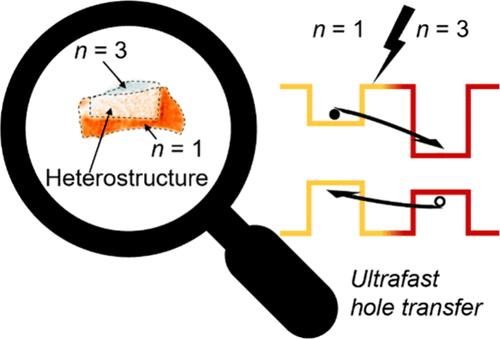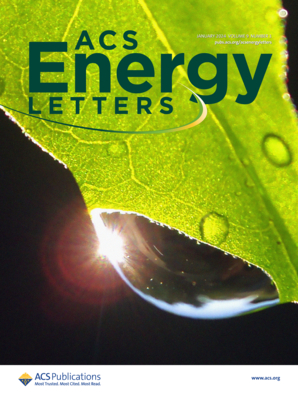Imaging Ultrafast Charge Transfer at Low-Dimensional Lead Halide Perovskite Heterostructures
IF 18.2
1区 材料科学
Q1 CHEMISTRY, PHYSICAL
引用次数: 0
Abstract
Addressing interface physics and related photoinduced dynamics is crucial to understand charge carrier paths and losses and ultimately design efficient optoelectronic devices. However, such dynamics are often masked when bulky systems are investigated. In this work, we combine photoluminescence with ultrafast transient absorption microscopy to map charge transfer processes in few-layers-thick heterostructures made of low-dimensional (C6H5CH2CH2NH3)2(CH3NH3)n-1PbnI3n+1 perovskite flakes of different dimensionalities (n = 3) and (n = 1). We observe that the hole transfer process from the (n = 3) to the (n = 1) phase happens after exciton diffusion on a time scale of tens of picoseconds, whereas electron transfer is hindered by the high exciton binding energy and low diffusion coefficient within the (n = 1) phase. This study sets the stage for a deeper understanding needed for the smart development of new heterostructure combinations with different dimensionalities and band alignments.

低维卤化铅钙钛矿异质结构的超快电荷转移成像
处理界面物理和光致动力学对于理解电荷载流子路径和损耗以及最终设计高效光电器件至关重要。然而,当研究庞大的系统时,这种动态往往被掩盖。在这项工作中,我们将光致发光与超快瞬态吸收显微镜相结合,绘制了不同维数(n = 3)和(n = 1)的低维(C6H5CH2CH2NH3)2(CH3NH3)n- 1pbni3n +1钙钛矿薄片(n = 3)和(n = 1)构成的少层厚异质结构中的电荷转移过程。我们观察到,从(n = 3)相到(n = 1)相的空穴转移过程发生在激子扩散之后,时间尺度为几十皮秒;而(n = 1)相内的高激子结合能和低扩散系数阻碍了电子的转移。该研究为智能开发具有不同维度和能带对准的新型异质结构组合提供了更深入的理解。
本文章由计算机程序翻译,如有差异,请以英文原文为准。
求助全文
约1分钟内获得全文
求助全文
来源期刊

ACS Energy Letters
Energy-Renewable Energy, Sustainability and the Environment
CiteScore
31.20
自引率
5.00%
发文量
469
审稿时长
1 months
期刊介绍:
ACS Energy Letters is a monthly journal that publishes papers reporting new scientific advances in energy research. The journal focuses on topics that are of interest to scientists working in the fundamental and applied sciences. Rapid publication is a central criterion for acceptance, and the journal is known for its quick publication times, with an average of 4-6 weeks from submission to web publication in As Soon As Publishable format.
ACS Energy Letters is ranked as the number one journal in the Web of Science Electrochemistry category. It also ranks within the top 10 journals for Physical Chemistry, Energy & Fuels, and Nanoscience & Nanotechnology.
The journal offers several types of articles, including Letters, Energy Express, Perspectives, Reviews, Editorials, Viewpoints and Energy Focus. Additionally, authors have the option to submit videos that summarize or support the information presented in a Perspective or Review article, which can be highlighted on the journal's website. ACS Energy Letters is abstracted and indexed in Chemical Abstracts Service/SciFinder, EBSCO-summon, PubMed, Web of Science, Scopus and Portico.
 求助内容:
求助内容: 应助结果提醒方式:
应助结果提醒方式:


